Picture this scenario: your manufacturing company's website gets steady traffic every month. Analytics show visitors spending time on your pages. Marketing feels good about the numbers. But when you check with sales, they're frustrated. "Where are all these leads you promised?" they ask. Sound familiar?
The truth is, B2B conversions work differently than what most people expect. Your buyers aren't making snap decisions like someone shopping for shoes online. They're part of teams, answering to bosses, and working with budgets that need approval from multiple departments. A visitor to your engineering firm's website might love what they see, but they still need to convince their CFO, run it by procurement, and get technical approval from their team.
This complexity means gut feelings about what works on your website often miss the mark. You need real data to understand what's happening when potential customers visit your site. Are they finding the technical specifications they need? Do they trust you enough to reach out? Can they even figure out what you do in the first place?
This guide walks you through practical, data-driven strategies to turn your B2B website into a machine that actually generates qualified leads. We'll cover how to measure what matters, understand your visitors' behavior, test improvements systematically, and avoid the costly mistakes that plague most B2B sites. By the end, you'll have a clear roadmap for making your website work harder for your business.
Understanding Your B2B Conversion Baseline
What Actually Counts as a Conversion in B2B?
Before you can improve conversions, you need to define what a conversion means for your business. In B2B, this gets tricky because not all actions carry equal weight.
A conversion might be:
- Someone downloading your white paper on industrial automation best practices
- A form submission requesting a quote for your consulting services
- Scheduling a demo of your construction management software
Each of these actions signals different levels of interest and readiness to buy.
Macro vs. Micro Conversions
Think of conversions in two categories:
- Macro Conversions: These are the big wins – demo requests, quote submissions, direct contact forms. These usually indicate someone is seriously evaluating you as a vendor.
- Micro Conversions: These are smaller commitments – newsletter signups, resource downloads, webinar registrations. These suggest interest but not immediate buying intent.
These different conversion types reveal varying levels of buyer intent, helping marketing and sales teams better qualify prospects and tailor follow-up strategies.
Setting Up Your Measurement Foundation
You can't improve what you don't measure, but many B2B companies are flying blind when it comes to conversion data. Setting up proper tracking doesn't require a PhD in analytics. You just need the right tools configured correctly.
Analytics Tracking
Start with Google Analytics 4 (GA4). Yes, it has a learning curve, but it's free and powerful enough for most B2B companies. Set up conversion events for each important action on your site. Make sure you're tracking:
- Form submissions
- Phone clicks
- Key button clicks
Don't forget to exclude your own team's traffic – you'd be surprised how much internal browsing can skew your data.
Heat Mapping Tools
Add a heat mapping tool like Hotjar or Microsoft Clarity. These show you:
- Where people actually click
- How far they scroll
- Where they get stuck
Watching real session recordings of visitors struggling with your site can be eye-opening. That beautiful design your agency created might be confusing the heck out of potential customers.
Calculating Your Current Conversion Rate
Here's a reality check: the average B2B website converts between 2-3% of visitors. That means 97-98 out of every 100 visitors leave without taking any meaningful action. Some industries do better, some worse, but if you're converting less than 1%, you have serious problems to address.
To calculate your conversion rate accurately: Divide the number of conversions by the number of unique visitors (not page views) over a specific period.
But here's the catch – your overall conversion rate might be misleading. A construction company client of ours had a decent 2.5% conversion rate overall, but when we dug deeper, we found their service pages converted at 8% while their blog converted at 0.1%. The blog was driving tons of unqualified traffic that diluted their numbers.
Look at conversion rates for different segments.
- How do visitors from organic search convert versus paid ads?
- What about mobile versus desktop users?
These insights tell you where to focus your optimization efforts.
Related Reading:
The Data Collection Phase: Know Your Visitors
Quantitative Data: The Numbers Tell a Story
Numbers reveal patterns humans miss. Your analytics data contains stories about what works and what doesn't on your site. But you need to look beyond surface metrics like total traffic.
Track Key Metrics
- Bounce Rate: This metric tells you if people immediately realize they're in the wrong place. For B2B sites, anything over 60% suggests a problem – maybe your value proposition isn't clear, or you're attracting the wrong audience.
- Time on Page & Scroll Depth: These metrics show engagement levels. If visitors spend four minutes on your capabilities page but only 30 seconds on your contact page, something on that contact page is scaring them away.
Analyze Heat Maps
Heat maps add visual context to these numbers. You might discover that visitors constantly click on an image thinking it's a button, or that nobody scrolls past your hero section to see your differentiators. Session recordings take this further – you can literally watch frustrated visitors try to find information, fail, and leave.
Optimize Forms
Form analytics deserve special attention. Where exactly do people abandon your forms? If everyone fills in their name and email but bails at "Company Revenue," maybe that field is too invasive for initial contact.
One professional services firm we know increased form completions by 40% just by moving required fields around and making some optional.
Qualitative Data: The Human Side
Numbers show you what's happening, but not why. For that, you need to hear from actual humans. This qualitative data often reveals problems you'd never catch through analytics alone.
Gather Insights from Exit Surveys
Exit intent surveys catch visitors as they're leaving. A simple question like "What stopped you from contacting us today?" can uncover major obstacles. Maybe they couldn't find pricing information. Perhaps they needed a specific certification you have but don't mention prominently. These insights are gold for optimization.
Talk to Sales
Your sales team sits on a treasure trove of insight. They hear the same objections repeatedly. They know what questions prospects always ask. They understand what finally convinces someone to move forward.
One manufacturing client discovered through sales feedback that prospects always wanted to know about their testing capabilities – information buried three levels deep on their website. Moving it to the homepage increased qualified leads by 35%.
Creating Your Visitor Personas Based on Data
Forget fictional personas based on assumptions. Use your actual data to understand who visits your site and what they need. Combine your quantitative and qualitative insights to build realistic profiles of your visitors.
You might discover that technical evaluators spend lots of time on specification sheets and case studies, while executives skim your about page and jump straight to ROI calculators. Procurement professionals might search immediately for certifications and insurance information. Each group needs different information presented differently to move toward conversion.
Map Your B2B Buyer’s Journey
Map content to each persona's journey stage.
- Someone in early research mode needs educational content and industry insights
- Someone comparing vendors wants detailed differentiators and proof points
- Someone ready to buy needs clear next steps and reassurance they're making the right choice
Your strategic B2B website should serve all these needs clearly.
High-Impact Optimization Areas
Homepage Optimization
Your homepage has five seconds to communicate what you do and why someone should care. That's not an exaggeration – heat map data consistently shows that visitors make snap judgments about whether to stay or leave within seconds of landing.
Prioritize Above-the-Fold Content
Above the fold, visitors need to immediately understand three things:
- What You Do: Explain what you do in concrete terms (not "innovative solutions" but "automated packaging equipment for food manufacturers")
- Who You Serve: Share your target audience (mid-size construction firms, hospitals with 200+ beds, whatever your sweet spot is)
- What Sets You Apart: Highlight what makes you different from the dozen other companies that popped up in their Google search
Let’s take a look at a clear value proposition from adjustable structural support manufacturer Ellis Manufacturing. Visitors to the company’s homepage immediately understand:
- What They Do: Manufacture fall protection products
- Who They Serve: Those working on active construction sites
- What Sets Them Apart: Their hero message emphasizes innovative, OSHA-compliant products, while their logo reinforces 75 years of industry experience
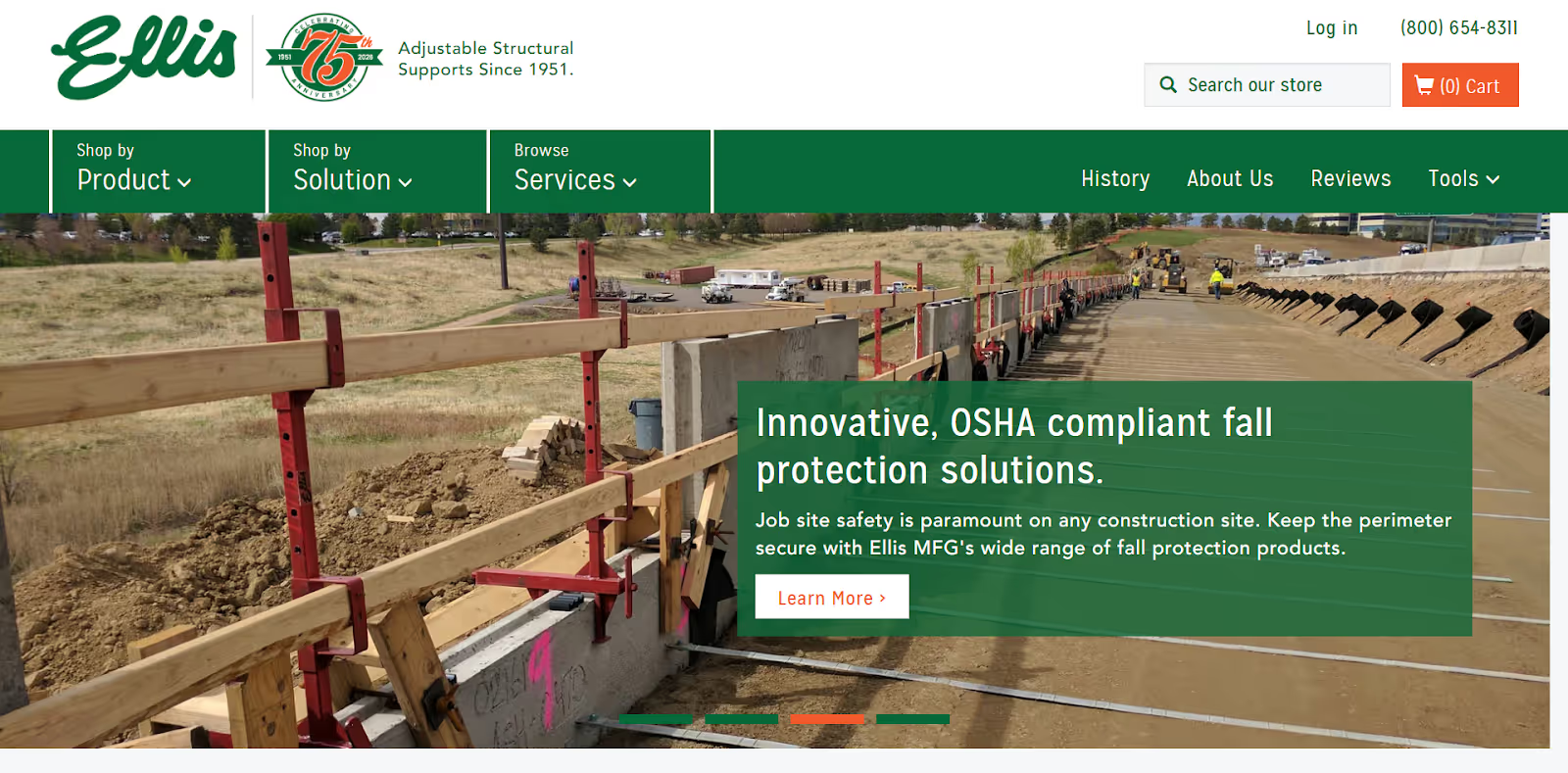
Clear value propositions like this one help visitors immediately understand if they're in the right place.
Add Trust Signals
Trust signals matter enormously in B2B. While consumer sites might show Instagram followers, you need credibility markers that matter to businesses. Confidence builders include:
- Industry certifications
- Years in business
- Notable clients (with logos if possible)
- Safety records
A structural engineering firm increased homepage conversions by 20% simply by adding "Licensed in all 50 states" and "Zero safety incidents since 1995" near their main call-to-action.
Implement Strategic Navigation
Navigation needs to guide, not overwhelm. We see too many B2B sites with massive mega-menus that paralyze visitors with options. Your main navigation should reflect how visitors think about their needs, not your internal organization structure. "Solutions by Industry" beats "Products" every time.
Landing Page Excellence
Landing pages for your paid campaigns or specific offers need laser focus. Every element should drive toward one specific action. Unlike your homepage that serves multiple audiences, a landing page has one job: convert a specific type of visitor.
Align Your Messaging
The message match between your ad and landing page is critical. If your Google ad promises "Free Consultation on OSHA Compliance," the landing page headline better mention that free consultation immediately. Any disconnect causes confusion and kills conversions. We've seen conversion rates double just from tightening this message match.
Implement Progressive Profiling
B2B forms require careful balance. Yes, you want qualified leads, but asking for too much information upfront scares people away. Start with essentials like:
- Name
- Company
- One qualifying question
You can gather more details later through progressive profiling. A consulting firm we work with increased form completions by 60% by cutting their form from 12 fields to 5, then following up for additional information.
Prioritize the Mobile Experience
Mobile experience matters more than many B2B companies realize. Over 50% of B2B research happens on mobile devices, often after hours when decision makers finally have time to research solutions. Your landing pages need to work flawlessly on phones and tablets, with easily tappable buttons and forms that don't require pinching and zooming.
Product/Service Page Improvements
Your product and service pages are where serious buyers spend time. They've moved past general interest and want specifics. These pages need to balance technical detail with clarity.
Focus on Benefits
Features tell, but benefits sell. Yes, your industrial pump moves 500 gallons per minute. But what matters to your buyer is that this means 30% less downtime during changeovers, saving them $50,000 annually. Connect every feature to a business outcome your buyers care about.
Place Social Proof Strategically
Case studies and social proof need strategic placement. Don't bury them at the bottom or hide them in a separate section. Weave proof points throughout your service descriptions. "Our predictive maintenance software helped Acme Manufacturing reduce equipment failures by 75%" is far more powerful than generic claims of excellence.
Present Specs in Stages
Technical specifications still matter in B2B, but present them progressively. Start with high-level benefits and business outcomes, then offer detailed specs for those who need them. PDF downloads for detailed technical documentation work well – they're also another micro-conversion you can track.
How Acme Balances Technical Specs with Business Benefits
Let’s take a look at Acme’s “Pallet Handling” solutions page to see what this strategy looks like in action. Directly beneath the hero image, Acme emphasizes four core benefits of their pallet handling systems:
- Higher accuracy
- Higher storage capacity
- Increased productivity
- Increased savings
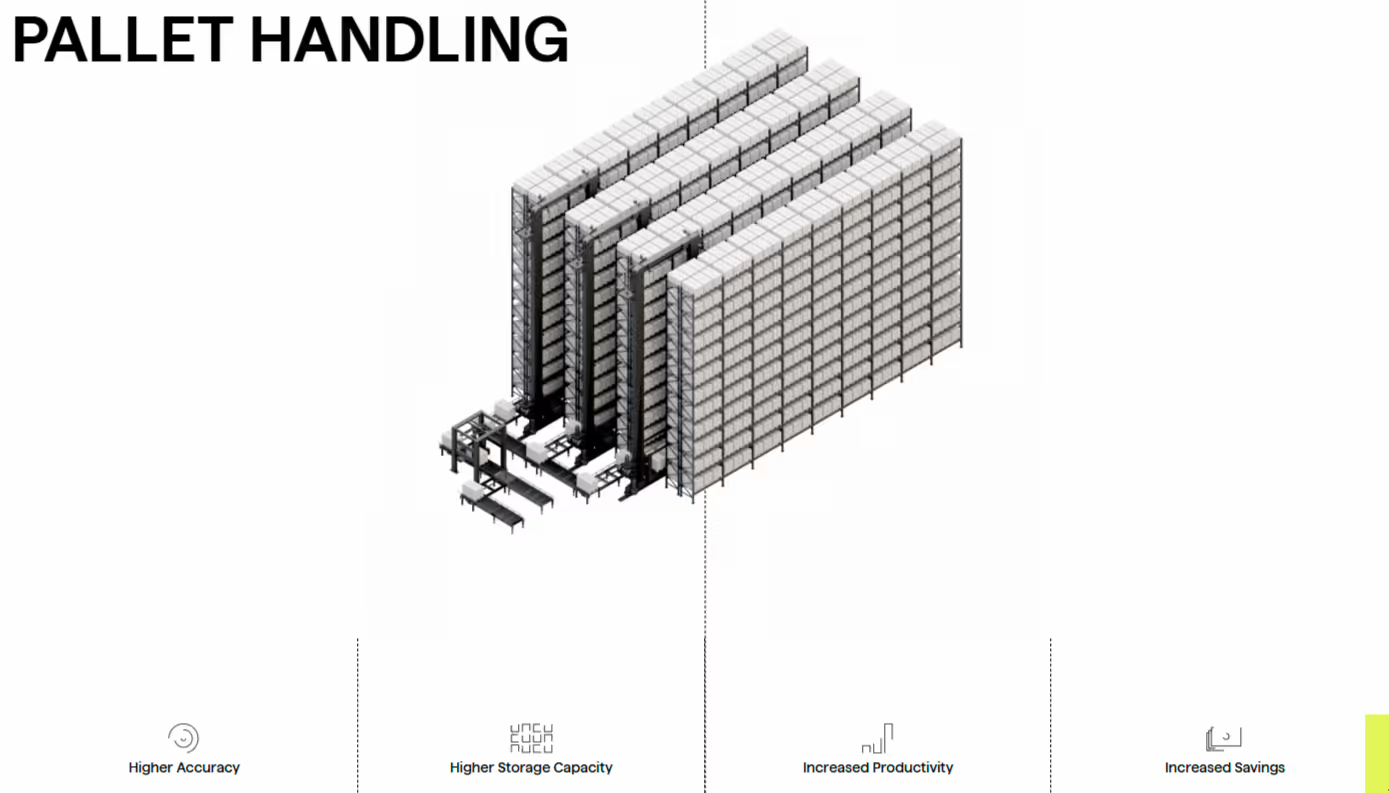
These concise statements quickly convey the value proposition, appealing to decision-makers seeking efficiency and cost-effectiveness. The page then features a chart identifying common challenges that prospects face when it comes to pallet handling, such as:
- Throughput capacity
- Space management
- Handling speed
- Product & worker safety
For each challenge, Acme presents the key issues with manual handling before showcasing how each of their tailored solutions addresses these issues.
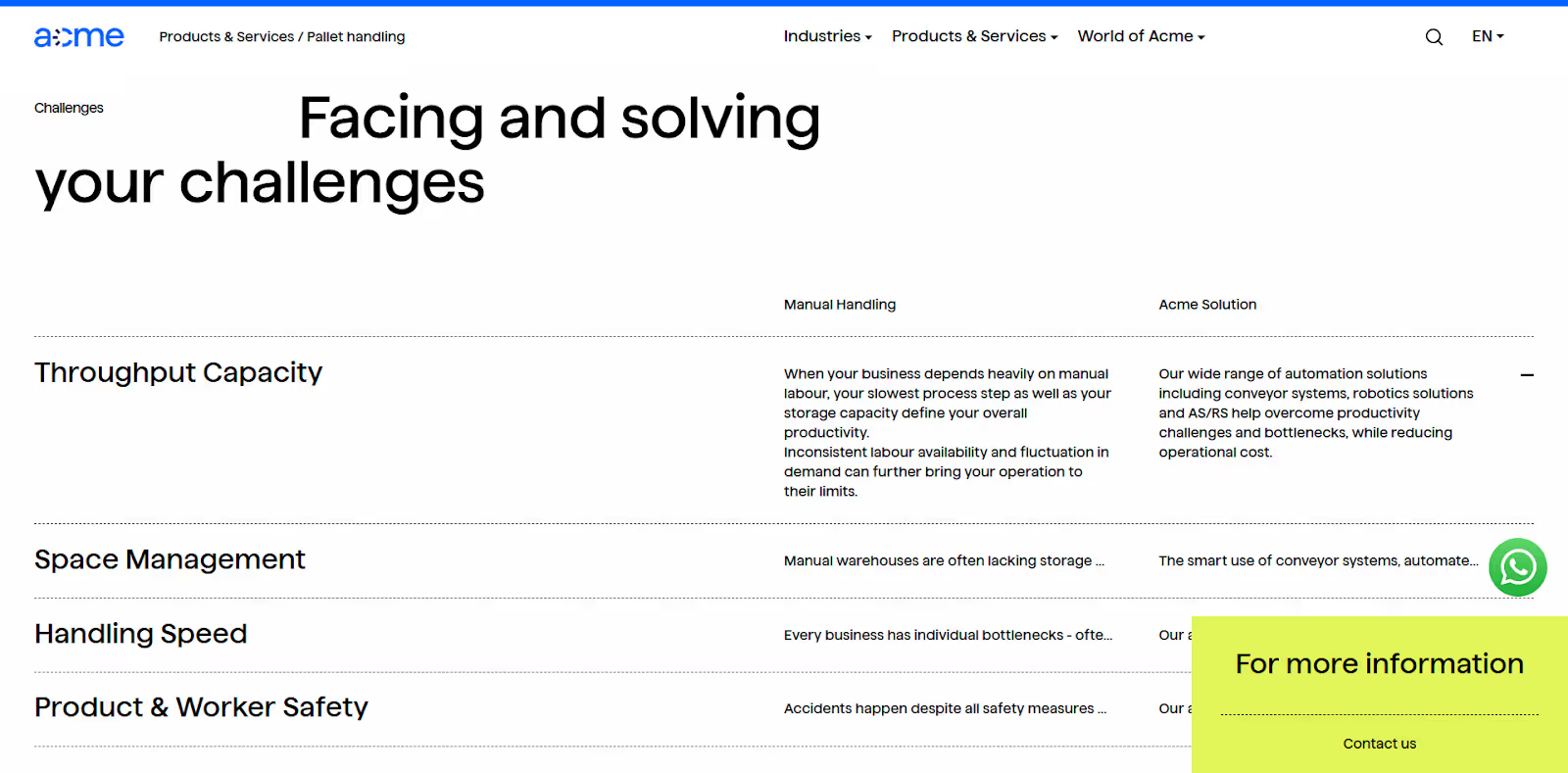
Next is a customizable solutions chart, allowing users to select their specific requirements, explore various configurations, and see the suggested components likely to match their unique needs. This interactive feature enhances user engagement and aids in decision-making.
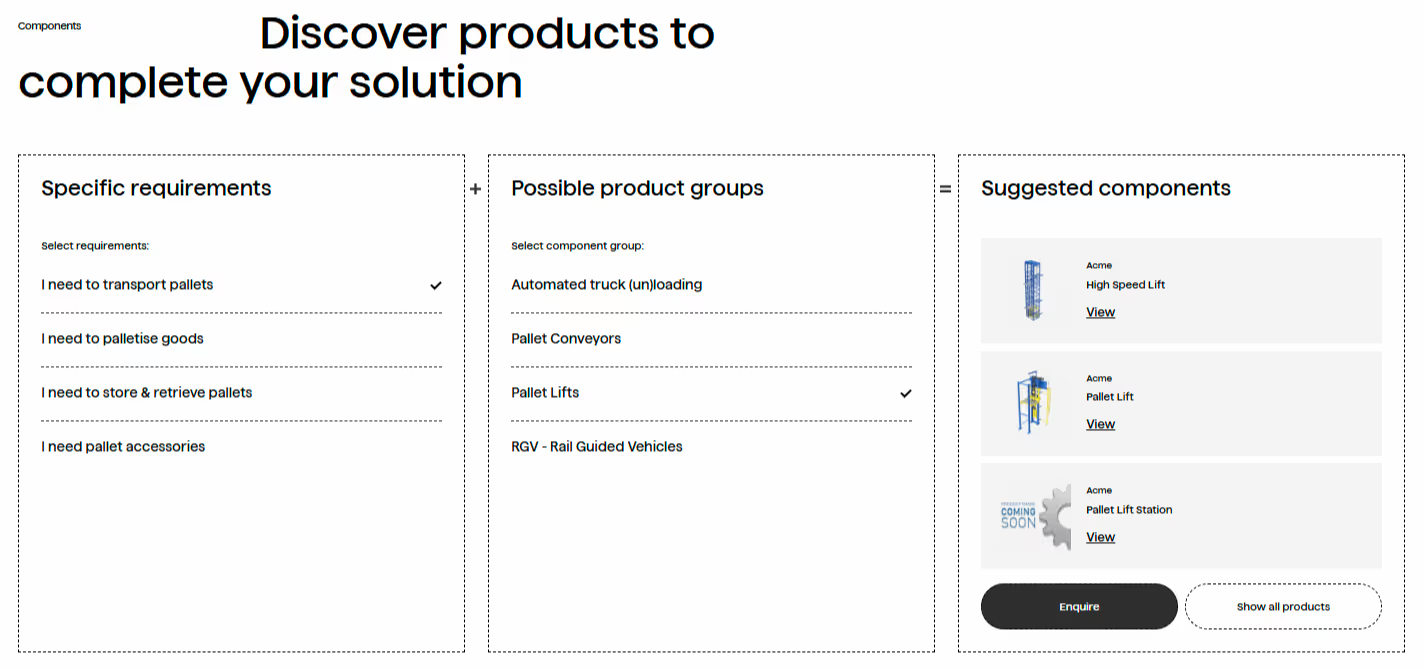
To further establish credibility, the page concludes by linking to brochures, buyers’ guides, case studies, and videos. These resources offer in-depth information, real-world applications, and testimonials that reinforce Acme's expertise and reliability in the industry.

By integrating these elements into their solutions page, Acme effectively communicates the advantages of their pallet handling systems, building trust and guiding potential customers through the decision-making process.
Forgotten Pages That Convert
Some of your highest-converting pages might be ones you rarely think about.
About Page
Your About page gets more traffic than you'd expect. B2B buyers want to know who they're dealing with. They want to know:
- Are you stable?
- Do you have the expertise they need?
- Will you be around in five years?
That’s why your About page must:
- Tell your story
- Showcase your team's expertise
- Reinforce your credibility
Manufacturing clients especially want to see your:
- Facilities
- Certifications
- Leadership team
Real photos beat stock photography every time. One industrial supplier saw contact form submissions increase 25% after replacing generic stock photos with actual pictures of their warehouse and team.
Contact Page
The Contact page seems simple but often creates unnecessary friction. Make it easy to reach you multiple ways. Be sure to include your:
- Phone number
- Email address
- Physical address
- Contact form
- Hours of operation
- Expected response times
If you have multiple locations or departments, help visitors reach the right person quickly.
Price Page
Pricing pages are controversial in B2B. While you might not list exact prices, giving visitors some sense of investment level helps qualify leads. "Projects typically range from $25,000 to $100,000" or "Most clients invest $2,000-5,000 monthly" sets expectations and filters out mismatched prospects.
Related Resources:
- B2B Buyer Journey Mapping: Building Websites That Convert
- B2B Website Design Best Practices: The Complete 2025 Guide
Testing Your Way to Better Conversions
A/B Testing Fundamentals for B2B
A/B testing removes guesswork from decision-making. Instead of debating whether a green or blue button works better, you let actual visitors vote with their clicks. But B2B testing requires patience and strategy that differs from high-traffic consumer sites.
Here’s what to test first:
- Headlines and Value Propositions: These usually offer the biggest potential gains.
- Main Call-to-Action Buttons: These come next. Test both the wording and the design.
- Forms: Form optimization can yield quick wins too. Should you ask for phone numbers? Is "Company Size" killing conversions? Testing reveals the answers.
Wait for Statistical Significance
B2B sites often have lower traffic than B2C, which means tests take longer to reach statistical significance. A test that might take Amazon two hours could take your industrial equipment site two months. This is normal. Resist the temptation to call tests early. We've seen too many companies make sweeping changes based on the first 20 conversions, only to see results reverse as more data comes in.
Test Regularly
The tools don't need to be complicated. Google Optimize shutting down disappointed many, but alternatives like VWO or even simple redirect tests work fine. Some companies just use their marketing automation platform to test different landing page versions. The specific tool matters less than the discipline of testing regularly.
Avoid Common Mistakes
Common testing mistakes can waste months of effort. Here are a few frequent mistakes to avoid (and why):
- Testing too many things simultaneously means you won't know what caused any change.
- Starting with tiny tweaks like button colors instead of meaningful changes like value propositions wastes time.
- Not documenting your tests and learnings means you'll repeat the same experiments later.
Beyond Button Colors: Tests That Matter
Forget the mythology about changing a button from red to green doubling conversions. Real B2B testing focuses on elements that actually influence complex buying decisions.
Test Value Propositions
Value proposition testing can transform your results. One engineering consultancy tested three different homepage headlines:
- Version A: "30 Years of Engineering Excellence" emphasized experience
- Version B: "Engineering Solutions Delivered 40% Faster" focused on speed
- Version C: "Reduce Project Overruns by Half" highlighted outcomes
Version C won by a landslide, increasing qualified leads by 47%. The lesson? Your buyers care more about their outcomes than your accolades.
Test Lead Magnets
Lead magnet effectiveness varies wildly. That comprehensive 50-page industry report might get fewer downloads than a simple checklist or template. Test different offers to see what your audience actually values. A construction software company found that a simple project budget template outperformed their detailed white papers by 3-to-1 for generating quality leads.
Test Live Chat
The chat versus no chat debate rages in B2B. Some sites see conversions jump with live chat. Others find it distracts from their primary calls-to-action. The only way to know is to test it with your specific audience.
When you do test chat, also test:
- Trigger timing
- The initial message
- Whether it should appear on all pages or just specific ones
Test Video vs. Text Explanations
This is another worthy test. While we often assume busy executives prefer quick text, sometimes a two-minute video explanation converts better than paragraphs of copy. This is especially true for complex technical products that benefit from visual demonstration.
Creating Your Testing Calendar
Random testing produces random results. You need a systematic approach to testing that builds knowledge over time. A testing calendar keeps you disciplined and prevents test conflicts.
Prioritize Testing Ideas
Start by listing all your test ideas and prioritizing them by potential impact. High-traffic pages with low conversion rates usually offer the most opportunity. Pages that deserve attention first include your:
- Homepage
- Main service pages
- Primary landing pages
That blog post from 2019 that gets three visitors monthly can wait.
Document Everything
Write down everything about each test, like:
- What was your hypothesis? ("Adding testimonials near the form will increase trust and improve conversions")
- What exactly did you change?
- What were the results?
- What did you learn?
This documentation becomes invaluable when new team members join or when you're planning future tests.
Run Tests Consistently
Build testing into your routine, not just your panic response to low numbers. Aim for at least one significant test running at all times. As one test concludes, have the next ready to launch. This momentum keeps you improving continuously rather than in fits and starts.
Content's Role in B2B Conversions
Content That Converts vs. Content That Informs
Not all content serves the same purpose. Blog posts that rank well in Google might drive traffic, but do they drive conversions? You need both informational content for SEO and awareness, plus conversion-focused content that moves buyers toward action.
Bottom-of-Funnel Content
Bottom-of-funnel content speaks to buyers ready to make decisions. These aren't broad educational pieces but specific, detailed resources that address final concerns, like:
- Comparison guides
- Implementation roadmaps
- ROI calculators
- Detailed case studies
This content often converts at 5-10 times the rate of top-of-funnel blog posts.
Case Studies
Case studies sell without selling because they let success stories do the persuasion. But generic case studies that just say "Client was happy" waste everyone's time. Effective case studies follow a structure:
- Specific challenge
- Why other solutions failed
- Your unique approach
- Measurable results
- Unexpected benefits
Include real numbers whenever possible. "Reduced inspection time by 73%" beats "significantly improved efficiency" every time.
Case Study Storytelling That Builds Trust and Credibility
PwC Global’s website features a number of compelling case studies, such as their cloud ERP risk automation case study. This case study explains how a global tax technology leader partnered with the management consulting firm to embed configurable controls into its Salesforce and Workday platforms.
Why is this case study so effective? It combines technical rigor with business clarity. A quick overview at the top reveals how working with PwC Global resulted in faster decisions, smoother audits, lower risk, and stronger shareholder value.
Below that, the use of concrete metrics (33% boost in configurable controls, 36% of staff time saved, 27% drop in access violations) immediately communicates measurable value, making the results tangible and credible. These numbers don’t just impress; they show how the solution drives efficiency, risk reduction, and stronger business outcomes.
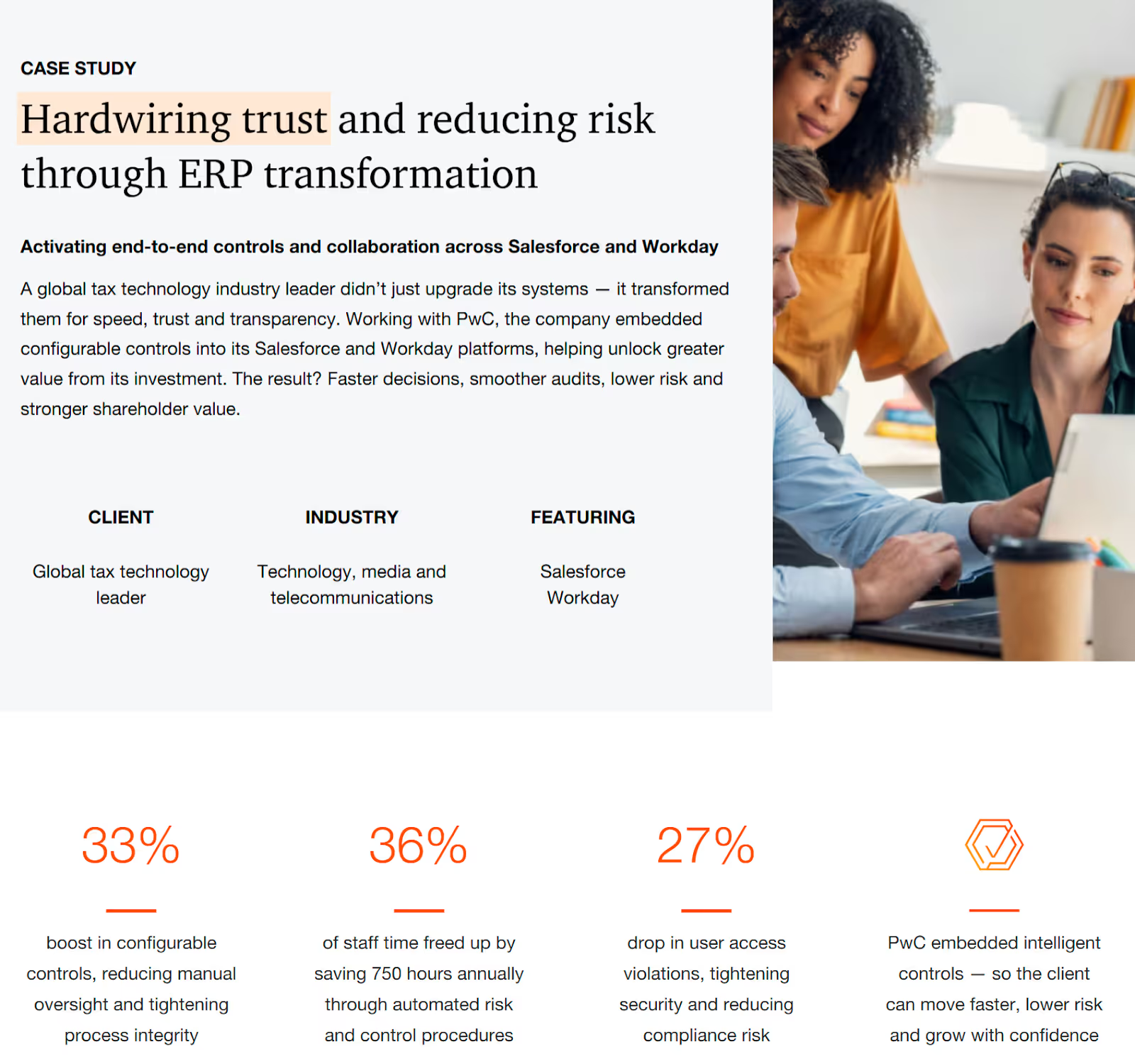
The rest of the case study is broken into clear, digestible sections, each of which tells a specific piece of the story:
- The challenge
- The solution
- The innovation
- The real-world impact
It’s easy for busy B2B buyers to scan and understand the transformation without getting lost in jargon.

For B2B marketers, this approach is a model: structure your case studies with clear problem–solution–impact storytelling, highlight quantifiable results, and always tie technical details back to business outcomes in order to build credibility and drive conversions.
The Power of Comparison Content
Buyers are comparing you to alternatives whether you acknowledge it or not. Comparison content helps you control that narrative while capturing high-intent search traffic.
Create “Versus” and “Alternative” Pages
"Versus" pages compare you to specific competitors. But they require careful handling.
- Focus on factual differentiators rather than disparaging competitors
- Highlight where you excel while acknowledging where others might be better fits
This honesty actually builds trust. A software company that admitted a competitor was better for enterprises with over 1,000 employees saw their sub-1,000 employee conversions increase because buyers trusted their transparency.
“Alternative” pages cast a wider net. "Top 10 Alternatives to [Competitor]" pages rank well and position you among the options. Even if you're number three on your own list, you're controlling the narrative and capturing valuable comparison traffic.
Provide Helpful Evaluation Content
Helping buyers make decisions means creating content that addresses their evaluation criteria, such as:
- Buyers' guides
- Selection checklists
- Vendor evaluation templates
These content types all provide value while subtly highlighting your strengths. Make these genuinely helpful, not just thinly veiled sales pitches.
Resource Centers That Generate Leads
Your resource center or library can become a conversion engine if structured strategically. Too many B2B sites dump all their PDFs in one place and call it a resource center. That's a missed opportunity.
Test Gated vs. Ungated Content
The gated versus ungated debate depends on your goals and content value. Generally, gate your most valuable, bottom-funnel content – the stuff that requires real investment to create. Keep top-funnel educational content open to build trust and SEO value.
But test this assumption. Some companies find that ungating everything but requiring registration for downloads provides the best balance.
Implement Progressive Profiling
Progressive profiling through content works brilliantly in B2B. Here’s an example:
- First Download: You might ask just for a name and email.
- Second Download: Consider requesting the visitor’s company and role.
- Third Download: You might include a budget timeframe.
- Fourth Download: By this interaction, you should have a fully qualified lead (without ever presenting an intimidating long form).
Establish Systematic Nurture Paths
Nurture paths after download keep conversions coming. For instance, someone who downloads your manufacturing cost reduction guide should receive follow-up content about:
- Implementation
- Common mistakes
- Success stories
This systematic nurturing can double the conversion rate from content downloads to sales conversations.
For More Content Insights:
Technical Factors That Kill Conversions
Speed Matters More Than You Think
Your potential customers are busy people with zero patience for slow websites. Every second of load time directly impacts your conversion rate. The data is brutal: B2B sites that load in one second convert three times better than sites that take five seconds. Three times better. Let that sink in.
Yet most B2B sites, especially in traditional industries, treat site speed as an afterthought. "Our customers will wait," they say. "We're not Amazon." But your visitors have been trained by the fastest sites on the web to expect instant response. When your page takes forever to load, you're not just frustrating visitors – you're literally losing leads.
Implement Quick Wins
Quick wins for speed improvement don't require rebuilding your entire site.
- Compress those massive images from your latest facility tour
- Enable browser caching so returning visitors don't reload everything
- Minimize the fancy JavaScript animations that your agency insisted would impress visitors
A construction equipment dealer reduced their homepage load time from six seconds to two seconds just by optimizing images. Their form submissions increased by 40% the following month.
Mobile Experience for B2B
The myth that B2B happens only on desktop computers needs to die. Around 60% of B2B buyers use mobile devices to make queries and conduct research about vendors, products, and services. Your prospects research solutions on their phones during commutes, between meetings, and after the kids go to bed. If they land on your site and have to pinch, zoom, and scroll horizontally just to read your value proposition, they're gone.
Test Your Site on Real Devices
Responsive design is the minimum, not the goal. Just because your site technically works on mobile doesn't mean it's optimized for mobile users. Be sure to check:
- Can visitors easily tap your phone number to call?
- Do forms work smoothly without fighting with tiny fields?
- Does your navigation work with thumbs, not mouse pointers?
Testing on real devices reveals problems emulators miss. That dropdown menu that works perfectly on your desktop might be impossible to use on an actual iPhone. The PDF download that seems fine might fail completely on Android devices. Regular testing on various devices isn't paranoia – it's quality control.
Security and Trust Signals
Security isn't just an IT concern – it directly impacts conversions. That "Not Secure" warning in the browser bar when you don't have an SSL certificate? It's killing your credibility before visitors even read your headline. In B2B, where visitors might submit sensitive company information, security concerns can stop conversions cold.
Address Privacy Concerns
Beyond the basic SSL certificate, privacy concerns matter more every year. Your privacy policy shouldn't be an afterthought buried in the footer. Make it clear how you'll use visitor information. "We'll never spam you" might sound cheesy, but it actually helps.
One professional services firm saw form completions increase 15% by adding "Your information is secure and never shared" next to their contact form.
Ensure GDPR Compliance
GDPR compliance isn't just for European companies anymore. B2B buyers everywhere have become more privacy-conscious. Build trust through:
- Clear cookie notices
- Easy opt-outs
- Transparent data handling
These trust-building elements show that you're a professional operation that takes compliance seriously – important when you're asking someone to trust you with a major business decision.
How Salesforce Supports Trust With Transparency
“At Salesforce, trust has always been our #1 value and the cornerstone of our business,” says President and Chief Legal Officer Sabastian Niles. But Salesforce doesn’t just talk about trust. They show it.
For example, the company has created an entire “Salesforce Compliance” microsite that enables visitors to easily access essential trust-building elements like:
- Legal terms
- Terms of use
- Privacy policy information
- Cookie settings

Each of these links takes visitors to a well-structured hub page — like the “Legal” hub, which centralizes all critical legal and compliance information in one easy-to-navigate location. Visitors can quickly find documentation relevant to customers, partners, or suppliers, which signals transparency and accountability.
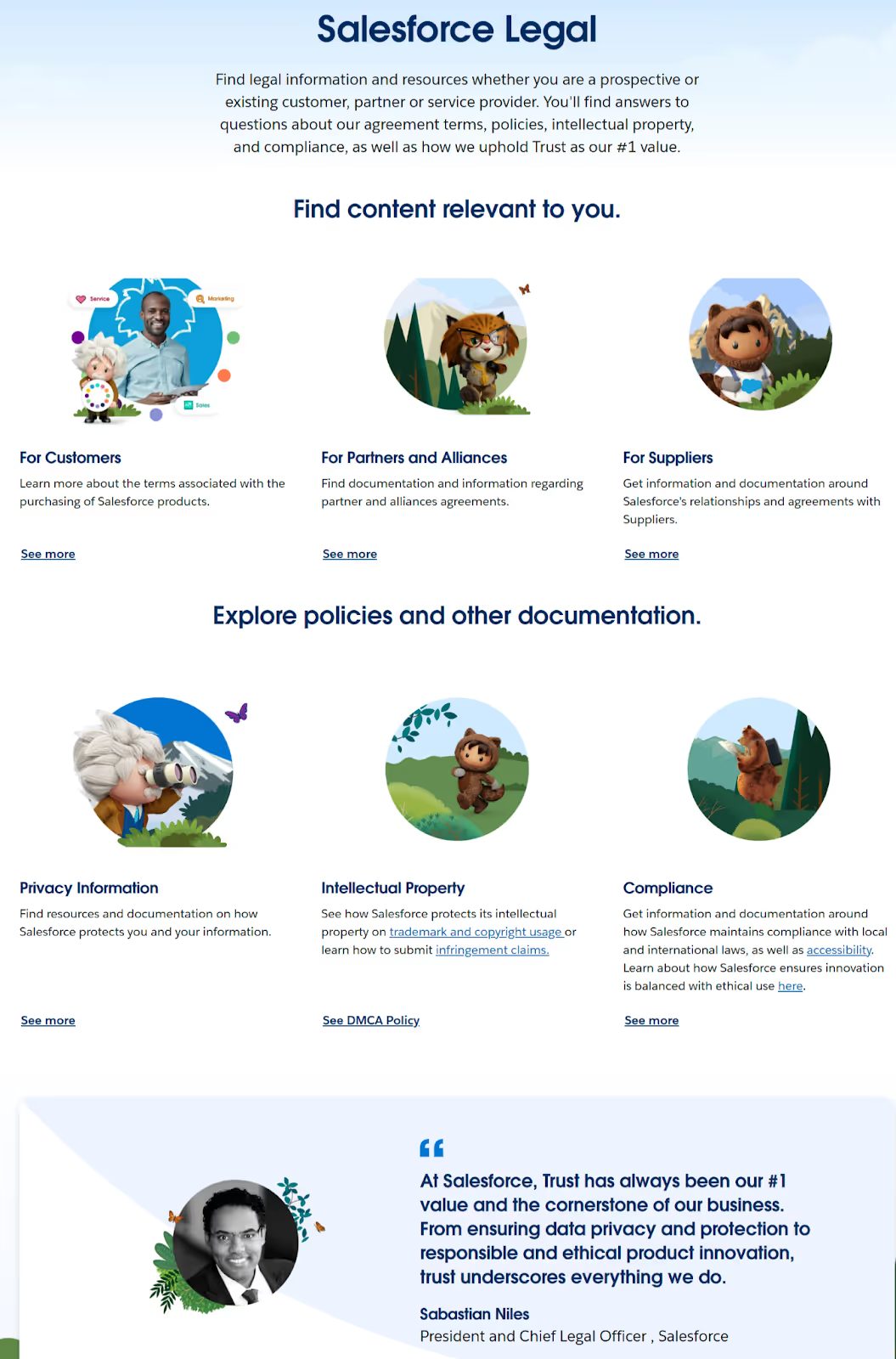
This robust resource hub reduces anxiety for businesses sharing sensitive data, demonstrating that Salesforce takes privacy, compliance, and ethical practices seriously.
Measuring Success and Continuous Improvement
KPIs That Matter for B2B
Vanity metrics feel good but don't pay the bills. Yes, it's nice that traffic increased 50%, but if those visitors aren't converting or aren't qualified, you're just burning bandwidth. Focus on metrics that connect to real business outcomes.
Track Lead Quality
Lead quality trumps lead quantity every time. A hundred leads mean nothing if your sales team wastes weeks calling unqualified prospects. Be sure to track:
- How many leads you generate
- How many become opportunities
- How many close
- What revenue they generate
One manufacturing client discovered their white paper downloads generated 10 times more leads than their demo requests, but the demo requests had a 20 times higher close rate. Guess where they focused their optimization efforts?
Establish a Sales Feedback Loop
The sales feedback loop is critical but often broken. Marketing celebrates increased conversions while sales complains about lead quality. Regular communication between teams ensures you're optimizing for the right outcomes.
Set up a simple system.
- Sales rates lead quality weekly
- Marketing shares what's working
- Both teams align on what a qualified lead really looks like
Calculate ROI
ROI calculation for optimization efforts keeps you honest. That fancy B2B website redesign might have cost $50,000. If it increases your conversion rate from 2% to 3%, what does that mean in real dollars? With 1,000 monthly visitors and an average deal size of $25,000, that 1% increase could mean an extra $300,000 annually. Now that redesign looks like a bargain.
Creating Your Optimization Roadmap
Random acts of optimization produce random results. You need a systematic approach that builds momentum over time. An optimization roadmap keeps you focused on high-impact improvements rather than getting distracted by shiny new tactics.
Review Opportunities Monthly
Monthly reviews keep you accountable. Be sure to:
- Check your key metrics
- Review test results
- Identify new opportunities
Ask yourself:
- What worked?
- What didn't?
- What surprised you?
These regular check-ins prevent you from setting and forgetting your optimization efforts.
Take Quarterly Deep Dives
Quarterly deep dives reveal larger patterns. Maybe:
- Mobile conversions are consistently lower across all pages
- Certain traffic sources never convert regardless of the landing page
These insights guide strategic decisions about where to invest resources.
Adjust Your Strategy Annually
Yearly adjustments account for market changes:
- Your buyers' expectations evolve
- New competitors enter the market
- Technology advances create new possibilities
What worked last year might not work today. Regular strategic reviews ensure your optimization efforts align with current reality, not past assumptions.
When to Bring in Help
Pride and budget constraints keep many B2B companies trying to handle everything internally. But there comes a point where expertise pays for itself. Recognizing when you've hit your optimization ceiling can save months of frustration.
Here are signs you need outside help:
- Conversion rates are stuck despite multiple tests
- There are technical limitations you can't overcome internally
- You simply lack time to do optimization properly
If you're spending more time fighting your website platform than improving conversions, it's time for help.
The cost-benefit calculation usually favors professional help for serious B2B companies. A conversion optimization specialist might cost $10,000 for a project. But if they increase your conversion rate from 2% to 3%, and you're generating $500,000 annually from your website, that's a $250,000 increase. The math is compelling.
Additional Optimization Resources:
- B2B Website Redesign: When to Update and How to Plan
- B2B Lead Generation: Proven Strategies for Local Market Growth
- B2B Website Design Best Practices: The Complete 2025 Guide
Conclusion: Your 30-Day Action Plan
Feeling overwhelmed? Don't be. Conversion optimization is a marathon, not a sprint. You don't need to fix everything at once. Small, consistent improvements compound into dramatic results over time.
Steps to Take in Month One
Week 1
Start with measurement:
- Define what conversions mean for your business
- Set up proper conversion tracking in Google Analytics
- Calculate your baseline conversion rates so you know where you're starting
- Install a heat mapping tool to start collecting behavioral data
This foundation makes everything else possible.
Week 2
Focus on gathering insights:
- Review your analytics to identify problem pages
- Run your first exit survey to ask visitors what stopped them from converting
- Talk to your sales team about common objections and questions
- Watch a few session recordings to see real users struggle with your site
These insights will reveal obvious improvements you can make quickly.
Week 3
This week is for quick wins. Fix the obvious problems you discovered, like:
- Simplifying a form
- Clarifying a confusing headline
- Adding trust signals to key pages
These aren't major overhauls – they're tweaks you can implement fast. You're building momentum and confidence for bigger changes.
Week 4
Launch your first real test. Pick one significant element to test – probably your main value proposition or primary call-to-action. Then:
- Set up the test properly
- Document your hypothesis
- Let it run
This starts your culture of testing and continuous improvement.
The Power of Compounding Improvements
The compound effect of optimization is real. A 10% improvement this month, another 15% next month, and suddenly you've doubled your conversion rate within a year. Each test teaches you something about your visitors. Each improvement makes the next one easier to identify.
Start with one thing today. Just one. Maybe it's adding your SSL certificate, or finally setting up conversion tracking, or simply asking your sales team what questions they hear most. That single action begins your journey toward a website that actually drives business growth. Your future self will thank you when those additional leads start rolling in.

